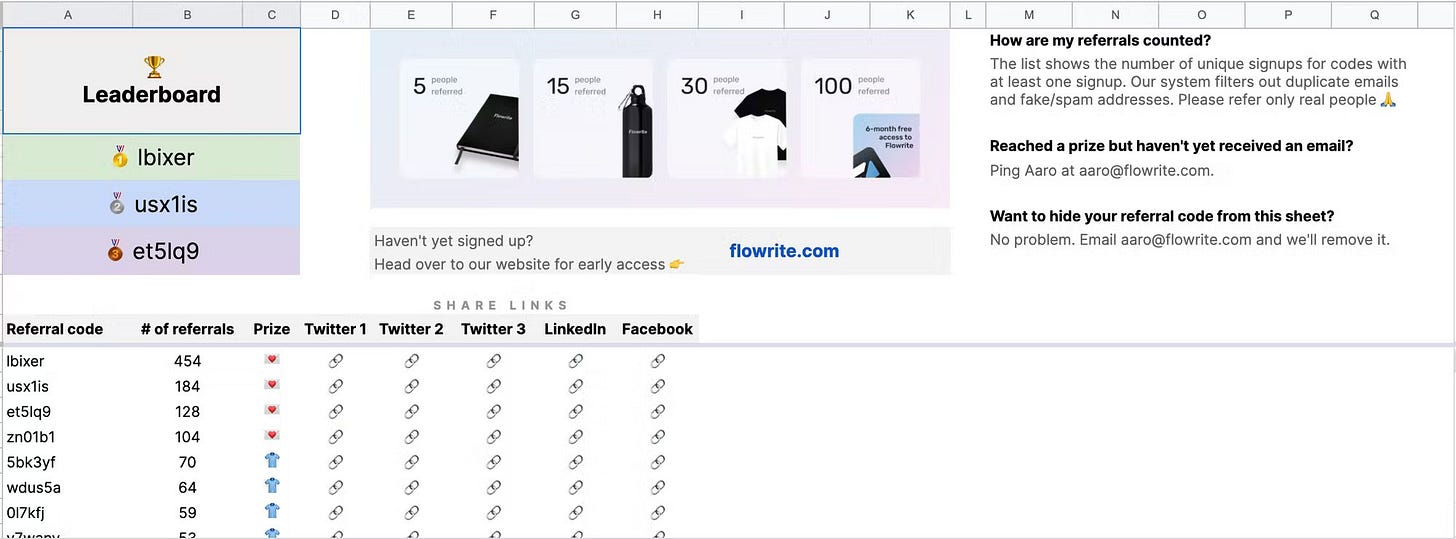Waitlists (Prt 2)
Growing that waitlist from scratch; taking it from 0 → 1000 → 🚀🌜
Hello Frens 👋,
Today I am revisiting a topic I touched upon a couple of weeks ago— Waitlists.
In case you missed it, in part 1 of this research project, I touched upon why and when does implementing a waitlist makes sense for a new venture.
Today is all about getting growing that waitlist from scratch; taking it from 0 → 1000 → 🚀🌜
—
A waitlist itself can be a product.
Suppose the primary goal of having a waitlist is to assess demand, increase word of mouth, capture top of funnel or improve paid marketing economics. In that case, treating it like a spinoff product with its own growth engines and viral mechanics makes sense. This is because a waitlist has:
Additional value axis to play on: early access, status, shaping product experience...etc.
A lower commitment bar than the actual product
As with any product, there are numerous true and tried tactics to seed the customer base before implementing a truly scalable works-while-you-sleep growth engine.
Seeding the waitlist
In this research, I focus primarily on how to grow a waitlist faster and more efficiently after having some resemblance initial traction going. Luckily myself (& others) have written in detail about getting the initial seed cohort of users onto a product (or onto your waitlist if we consider it its own product). The issues below are good starting points:
Growing the waitlist:
After having some initial traction, the next step would be leveraging that to develop a scalable engine to grow the waitlist. Below are some tips, tricks, and tactics I gathered from this research (+ with the help of some of the First 1000 members) to do just that.
Use Website Badges (h/t @deadcoder0904)
Xobni(acquired by Yahoo) asked bloggers to embed a badge at the bottom of their blog that said “Xobni for my inbox.” They used the badge to track clicks originating from blogs and prioritized access to those sending the most traffic.
Incorporate waitlist referrals in the signup flow
After signing up to well over 200 waitlists over the past 3 weeks, I found the process almost identical for every new product or app: I give them my email then fill up a 5-10 survey about why I need the product.
In Flowrite’s case, they ask for a recommendation as the 10th & last question in the joining our waitlist questionnaire, taking advantage of the Sunk Cost Fallacy (we are more likely to follow through on things we have already invested time, energy, or money in. In this case, it is filling the previous 9 questions)
Giving everyone free points (h/t @guipcoel)
Another play on consumer psychology is giving everyone that joins the waitlist some free points (or whatever mechanic is used to move up the waitlist). Maven Pet gives users 5 points as soon as they join. This way, they have some initial investment made in moving up the waitlist, and again, a higher likelihood to follow through.
Hard Cutoffs
Soon app has a hard cutoff of 1000 users for their beta. Anyone who does not make the cut is will have to wait for the public release. This artificial scarcity can increase motivation for people to take action and refer others.
Create non-referral tasks to move up the list (h/t @guipcoel)
Maven Pet offers low-effort tasks to move up the waitlist that does not depend on referring people and putting some social capital at risk. These include following the brand on social media and liking their posts.
$5 screenshots
Another way to facilitate growth is by rewarding effort instead of the outcome.
This is a more aligned incentive structure for users and offers a guarantee for their effort. Fizz, the student debit card, offered every student $5 for sending a screenshot of a post encouraging classmates to join the Fizz waitlist.
The only caveat, the post had to be in the university Slack group.
Transparent Leaderboards (h/t @tim_treagus)
Flowrite took the waitlist and turned it into a full-blown challenge. They had the entire leaderboard available for everyone’s to view. This way (or the hope is that), this level of transparency would appeal to the status-seeking monkeys we all are and get the competitive juices flowing in the brains of their potential users.
Refer & Move up
And, of course, the motherload of all waitlist growth tactics, the Refer & Move up. The Refer and Move up was used by Robinhood, Coinbase, Chime, and many others.
Refer & Skip
Another spin on the Refer & Move up is the Refer & Skip. The Refer & Skip gives users the privilege to skip the waitlist entirely if an active member referred them. This way, they get X2 the buzz around the product. Active users share their codes online, and non-users ask for them.
Clubhouse, Superhuman, Pitch, and Masterworks are amongst some of the biggest names who implemented the Refer & Skip.
—
When I first began researching waitlists and the growth mechanics behind them, I expected to find a little more than those 9 tactics.
While I could not be a part of every product with a waitlist, I signed up to well over 200 of them in the past 3 weeks alone + looked at another ~100 through the internet archive.
A little nugget I discovered through this process was that the vast majority (just over 55% of the waitlists I signed up for) had no growth engines: no referral codes, no waitlist position ..etc. Instead, those founders are just out there trying to build great products, and waitlists are their filtering mechanism to separate the valuable feedback from the noise.
This makes me happy.
Until we meet next Tuesday again 😉,
Ali Abouelatta








